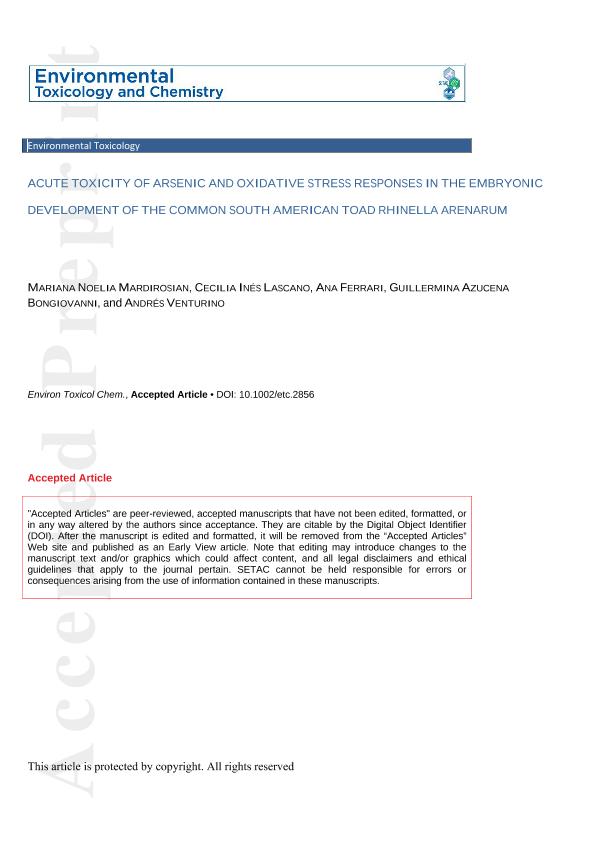Mostrar el registro sencillo del ítem
dc.contributor.author
Mardirosian, Mariana Noelia

dc.contributor.author
Lascano, Cecilia Ines

dc.contributor.author
Ferrari, Ana

dc.contributor.author
Bongiovanni, Guillermina Azucena

dc.contributor.author
Venturino, Andres

dc.date.available
2018-02-26T18:10:42Z
dc.date.issued
2015-05
dc.identifier.citation
Mardirosian, Mariana Noelia; Lascano, Cecilia Ines; Ferrari, Ana; Bongiovanni, Guillermina Azucena; Venturino, Andres; Acute toxicity of arsenic and oxidative stress responses in the embryonic development of the common South American toad Rhinella arenarum; Society of Environmental Toxicology and Chemistry; Environmental Toxicology and Chemistry; 34; 5; 5-2015; 1009-1014
dc.identifier.issn
0730-7268
dc.identifier.uri
http://hdl.handle.net/11336/37115
dc.description.abstract
Arsenic (As), a natural element of ecological relevance, is found in natural water sources throughout Argentina in concentrations between 0.01mg/L and 15mg/L. The autochthonous toad Rhinella arenarum was selected to study the acute toxicity of As and the biochemical responses elicited by the exposure to As in water during its embryonic development. The median lethal concentration (LC50) value averaged 24.3mg/L As and remained constant along the embryonic development. However, As toxicity drastically decreased when embryos were exposed from heartbeat-stage on day 4 of development, suggesting the onset of detoxification mechanisms. Given the environmental concentrations of As in Argentina, there is a probability of exceeding lethal levels at 1% of sites. Arsenic at sublethal concentrations caused a significant decrease in the total antioxidant potential but generated an increase in endogenous glutathione (GSH) content and glutathione S-transferase (GST) activity. This protective response might prevent a deeper decline in the antioxidant system and further oxidative damage. Alternatively, it might be linked to As conjugation with GSH for its excretion. The authors conclude that toad embryos are more sensitive to As during early developmental stages and that relatively high concentrations of this toxic element are required to elicit mortality, but oxidative stress may be an adverse effect at sublethal concentrations.
dc.format
application/pdf
dc.language.iso
eng
dc.publisher
Society of Environmental Toxicology and Chemistry

dc.rights
info:eu-repo/semantics/openAccess
dc.rights.uri
https://creativecommons.org/licenses/by-nc-sa/2.5/ar/
dc.subject
Amphibians
dc.subject
Antioxidant Potential
dc.subject
Aquatic Toxicology
dc.subject
Biomarkers
dc.subject
Glutathione S-Transferase
dc.subject.classification
Otras Ciencias Biológicas

dc.subject.classification
Ciencias Biológicas

dc.subject.classification
CIENCIAS NATURALES Y EXACTAS

dc.title
Acute toxicity of arsenic and oxidative stress responses in the embryonic development of the common South American toad Rhinella arenarum
dc.type
info:eu-repo/semantics/article
dc.type
info:ar-repo/semantics/artículo
dc.type
info:eu-repo/semantics/publishedVersion
dc.date.updated
2018-01-23T14:10:27Z
dc.journal.volume
34
dc.journal.number
5
dc.journal.pagination
1009-1014
dc.journal.pais
Estados Unidos

dc.journal.ciudad
Michigan
dc.conicet.avisoEditorial
This is the peer reviewed version of the following article: Mardirosian, Mariana Noelia; Lascano, Cecilia Ines; Ferrari, Ana; Bongiovanni, Guillermina Azucena; Venturino, Andres; Acute toxicity of arsenic and oxidative stress responses in the embryonic development of the common South American toad Rhinella arenarum; Society of Environmental Toxicology and Chemistry; Environmental Toxicology and Chemistry; 34; 5; 5-2015; 1009-1014, which has been published in final form at http://dx.doi.org/10.1002/etc.2856. This article may be used for non-commercial purposes in accordance with Wiley Terms and Conditions for Self-Archiving.
dc.description.fil
Fil: Mardirosian, Mariana Noelia. Universidad Nacional del Comahue. Facultad de Ingeniería. Departamento de Química. Laboratorio de Investigaciones Bioquímicas, Químicas y de Medio Ambiente; Argentina. Consejo Nacional de Investigaciones Científicas y Técnicas; Argentina
dc.description.fil
Fil: Lascano, Cecilia Ines. Universidad Nacional del Comahue. Facultad de Ingeniería. Departamento de Química. Laboratorio de Investigaciones Bioquímicas, Químicas y de Medio Ambiente; Argentina. Consejo Nacional de Investigaciones Científicas y Técnicas; Argentina
dc.description.fil
Fil: Ferrari, Ana. Consejo Nacional de Investigaciones Científicas y Técnicas. Centro Científico Tecnológico Conicet - Patagonia Norte. Instituto de Investigación y Desarrollo en Ingeniería de Procesos, Biotecnología y Energias Alternativas. Universidad Nacional del Comahue. Instituto de Investigación y Desarrollo en Ingeniería de Procesos, Biotecnología y Energias Alternativas; Argentina
dc.description.fil
Fil: Bongiovanni, Guillermina Azucena. Consejo Nacional de Investigaciones Científicas y Técnicas. Centro Científico Tecnológico Conicet - Patagonia Norte. Instituto de Investigación y Desarrollo en Ingeniería de Procesos, Biotecnología y Energias Alternativas. Universidad Nacional del Comahue. Instituto de Investigación y Desarrollo en Ingeniería de Procesos, Biotecnología y Energias Alternativas; Argentina
dc.description.fil
Fil: Venturino, Andres. Universidad Nacional del Comahue. Facultad de Ingeniería. Departamento de Química. Laboratorio de Investigaciones Bioquímicas, Químicas y de Medio Ambiente; Argentina. Consejo Nacional de Investigaciones Científicas y Técnicas; Argentina
dc.journal.title
Environmental Toxicology and Chemistry

dc.relation.alternativeid
info:eu-repo/semantics/altIdentifier/doi/http://dx.doi.org/10.1002/etc.2856
dc.relation.alternativeid
info:eu-repo/semantics/altIdentifier/url/http://onlinelibrary.wiley.com/doi/10.1002/etc.2856/abstract
Archivos asociados
